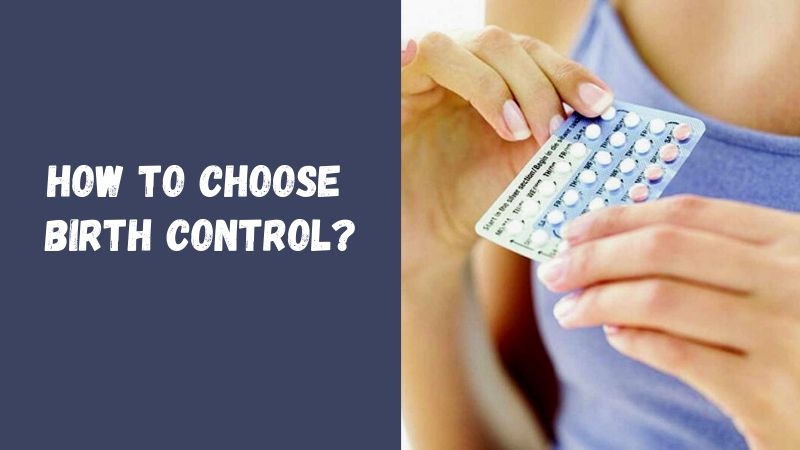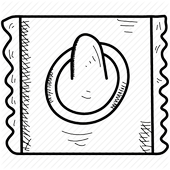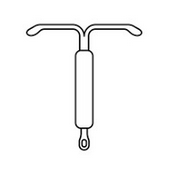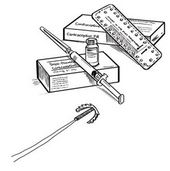The choice of method for preventing an unwanted pregnancy depends on many factors, for example, the woman’s age, desire to have children, habits and sexual behavior, the presence or absence of any concomitant diseases. It should be emphasized that there is no universal way to prevent pregnancy. What suits one woman or couple may not be suitable for others.

Contraception in early adolescence
Currently, puberty of girls occurs earlier than in previous generations. Insufficient maturity (both physical and mental) and the resulting irresponsibility lead to the fact that quite often teenage girls have many sexual partners.
It is also bad that they do not regularly use contraceptives or do not use them at all.
Often the first sexual contact leads to the first abortion. And not all women leave the abortion department with firm confidence that they will be able to have children in the future.
According to world statistics, the pregnancy rate among adolescents has increased significantly in recent years and continues to grow. Adolescence (15–18 years) accounts for up to 4 million abortions worldwide.
When choosing a contraceptive, adolescents of both sexes rarely think about the fact that during sexual contact they can become infected with some kind of infection, therefore the frequency of sexually transmitted diseases, including HIV infection, is growing. All this poses a huge danger to the health of the younger generation and to the health of society as a whole.
Contraception in adolescence has two main objectives – to prevent abortion and infection with sexually transmitted diseases.
If you are a teenager and want to have sexual relations, first of all, protect your health and the health of future children. What birth control is best in adolescence? The hormonal method is extremely undesirable during this age period. And do not forget that this method does not prevent infection with sexually transmitted diseases.
Birth control pills can only be taken if a teenager meets the following conditions:
- regular sexual activity;
- the first menstrual period occurred at least 2 years ago;
- hight at least 5’3″;
- no obesity;
- no serious diseases of the heart and blood vessels.
The World Health Organization recommends the following birth control pills to teenage girls: three-phase (Tri-Levlen, Enpresse, Myzilra, Triphasil, Trivora, Levonest ) and single-phase (Reclipsen, Ortho-Cept, Kalliga, Juleber, Cyred, Isibloom, Enskyce, Solia, Femynor, VyLibra, Mili, Previfem, Ortho-Cyclen, MonoNessa, Estarylla). They provide the least interference in the natural course of the processes occurring in the female body and maintain the stability of the menstrual cycle.
The use of mini pills is not recommended because their contraceptive effectiveness is lower and they cause side effects (intermenstrual spotting) more often.
Emergency contraception is an emergency measure to prevent unwanted pregnancy (although it is much preferable to abortion). Sometimes it is called “emergency contraception” in the literature because it requires urgent and effective measures. If a girl doubts the integrity of the condom when using it or if unprotected sexual contact has occurred, or if other methods of contraception cannot be used for one reason or another, she should use this method of pregnancy protection for the next 72 hours – three days (when using hormonal contraceptives) or 5–7 days if a decision is made to administer an intrauterine device (which is not recommended in adolescence).
The most acceptable method of emergency contraception is a combination birth control pill (Plan B, Morning-After Pill, Ella).
The introduction of intrauterine devices is carried out within 5-7 days after unprotected sexual intercourse. This method has a right to exist as a means of emergency contraception, but it is better for teenage girls not to use it because there is a high risk of inflammation of the uterus and its appendages, especially if a girl many sexual partners.
 The use of barrier methods of contraception reduces the risk of sexually transmitted diseases by more than 2-3 times, especially when using a condom. However, the contraceptive effectiveness of a condom in young people is low and amounts to 50–75% (due to improper use directly at the time of sexual intercourse). The simultaneous use of a condom and spermicides (pastes, creams, gels, etc.) is possible, it increases the effectiveness of barrier methods of contraception.
The use of barrier methods of contraception reduces the risk of sexually transmitted diseases by more than 2-3 times, especially when using a condom. However, the contraceptive effectiveness of a condom in young people is low and amounts to 50–75% (due to improper use directly at the time of sexual intercourse). The simultaneous use of a condom and spermicides (pastes, creams, gels, etc.) is possible, it increases the effectiveness of barrier methods of contraception.
The use of only spermicidal agents in adolescence is inappropriate since their contraceptive effect is low.
Due to the spread of HIV and other sexually transmitted diseases, we recommend that adolescents use condoms in combination with birth control pills, which will protect against unwanted pregnancy and sexually transmitted diseases (including AIDS).
Intrauterine devices, despite their relatively high effectiveness, are not recommended, especially for teenagers who do not have regular sex and change sexual partners frequently.
Contraception at the age of 19 – 35 years
As a rule, the majority of women aged 19–35 years are married, have children, or have had pregnancies that have ended in abortion or miscarriage. Usually, they study or work, have certain life experiences and control their behavior and sex. At this age, almost all methods of protection against pregnancy can be used.
All contraceptive methods and methods are suitable for women aged 19 and 35 years, but intrauterine devices are considered the best birth control option.
Intrauterine devices are the most popular method of contraception among women 19–35 years old. It is used by 25% of women of this age because the method is cheap and does not require constant self-control, which is necessary when taking birth control pills.
Intrauterine devices are recommended for young women who live a regular sexual life and do not have contraindications to this method of contraception.
 Hormonal birth control for women aged 19–35 years is one of the most effective and acceptable methods of preventing unwanted pregnancies. In addition, hormonal contraceptives also play an important role in the prevention of diseases such as menstrual irregularities, infertility, endometriosis. We recommend using low-dose combination pills (Iclevia, Ortho-Novum, Genora, Lo-Ovral, Modicon, Zumandimine, Demulen, Tri-Levlen, Leena, Tri Femynor, Tri-Norinyl, Tri-VyLibra, Tri-Mili, Tri-Legest) since they cause a minimal amount of side effects.
Hormonal birth control for women aged 19–35 years is one of the most effective and acceptable methods of preventing unwanted pregnancies. In addition, hormonal contraceptives also play an important role in the prevention of diseases such as menstrual irregularities, infertility, endometriosis. We recommend using low-dose combination pills (Iclevia, Ortho-Novum, Genora, Lo-Ovral, Modicon, Zumandimine, Demulen, Tri-Levlen, Leena, Tri Femynor, Tri-Norinyl, Tri-VyLibra, Tri-Mili, Tri-Legest) since they cause a minimal amount of side effects.
Barrier methods of contraception are recommended to women with an increased risk of contracting sexually transmitted diseases, those who have irregular or rare sex, who are breast-feeding, and who have contraindications to hormonal and intrauterine methods of contraception.
Biological methods of contraception (rhythmic method and interrupted sexual intercourse) are best combined with other methods since currently there are many modern and reliable means that can also have a beneficial effect on the female body.
Surgical sterilization is recommended primarily for women who do not wish to have children in the future, or those for whom pregnancy is contraindicated for health reasons. The effectiveness of this method of contraception is almost 100%, but it must be used very carefully because the changes caused by the surgical method are almost irreversible.
Contraception at the age of 35 – 45 years
At this age, pregnancies are often accidental since most women have already resolved issues related to family planning. An alarm is caused by the fact that about half of all pregnancies in this age group are interrupted by abortion, which has a harmful effect on a woman’s body, often leading to inflammatory diseases of the genitals, severe menopause, and an increased risk of developing tumor formations.
 Thus, pregnancy at this age is not only undesirable but also dangerous, including for the fetus, if it is decided to maintain pregnancy. So there is only one way out – timely and reliable contraception.
Thus, pregnancy at this age is not only undesirable but also dangerous, including for the fetus, if it is decided to maintain pregnancy. So there is only one way out – timely and reliable contraception.
The main difficulties in choosing pregnancy protection methods for women aged 35–45 years are associated with the presence of risk factors (overweight, smoking, concomitant diseases, etc.).
The recommended option at this age is an intrauterine device, but it is often contraindicated in connection with pathological changes in the tissues of the cervix and uterus, as well as other diseases.
Hormonal contraception
Pills
When choosing hormonal methods of contraception (in the absence of contraindications and bad habits, such as smoking), preference should be given to combination birth control pills of the last generation and three-phase drugs (Daisynelle, Denise, Femelle, Femigen, Femistad, Gestinyl, Gestodilat, Harmonet, Marvelon, Mercilon, Minero, Minulet, Modina).
Injections and products implanted under the skin
The main advantage is that intramuscular injection (once in 3 months) or implantation of an agent under the skin (once in 3-5 years) is more acceptable for many women than the daily use of tablets requiring constant self-monitoring.
The most common drugs in this group
Provera (Medroxyprogesterone), in addition to contraceptive action, reduces the risk of inflammatory diseases of the female genital organs, thrush of the vagina (candida vaginitis), pathological changes in the mucous membrane of the uterus and mammary glands. It is indicated for the treatment of endometriosis. Recovery of reproductive function after the cancellation of Provera occurs within 5–9 months (sometimes 24).
Jadelle (capsules implanted under the skin of the shoulder through a small incision under local anesthesia). The contraceptive effect is manifested already a day after administration and lasts for several years.
Surgical sterilization may be the best option if you are determined not to have more children. This method is popular in many countries of the world, however, you should remember that sterilization is an irreversible method of birth control and the subsequent restoration of reproductive function is impossible.
Barrier methods of contraception can be used by couples after 40–45 years of age who, according to established traditions, consider these drugs to be the most suitable (we should not forget that contraceptive effectiveness of these methods is low). Barrier methods are especially indicated in the presence of diseases that do not allow the use of more modern and effective agents.
Postpartum contraception
In the postpartum period, the woman’s body gradually regains its function. The restoration of ovarian activity and, accordingly, the possibility of a new pregnancy depend on many factors: the time elapsed since the birth, the duration of breastfeeding, the nutrition of the mother, etc.
 You must keep in mind an abortion performed in the coming months after childbirth has a very adverse effect on a woman’s health and her reproductive system, which is manifested by various gynecological diseases, the birth of debilitated children, premature births, and miscarriages. The main reason that women often have an abortion after childbirth is because women do not know how the use of contraceptives will affect breastfeeding, the quality of breast milk, and the growth and development of the baby. Although most puerperas do not want to become pregnant in the first few years after the birth of the baby.
You must keep in mind an abortion performed in the coming months after childbirth has a very adverse effect on a woman’s health and her reproductive system, which is manifested by various gynecological diseases, the birth of debilitated children, premature births, and miscarriages. The main reason that women often have an abortion after childbirth is because women do not know how the use of contraceptives will affect breastfeeding, the quality of breast milk, and the growth and development of the baby. Although most puerperas do not want to become pregnant in the first few years after the birth of the baby.
In addition, the increased sexual activity of the partner and the switching of all the interests of the woman to the child sometimes do not allow paying due attention to the prevention of pregnancy. Thus, during this period, the main task of both the doctor and the woman is the right choice of a reliable method of contraception, which would provide her with the necessary time to restore her health and care for the newborn and would not adversely affect the breastfeeding and development of the child.
Prolonged breastfeeding and the absence of menstruation (amenorrhea) associated with it play the role of a natural protective mechanism that protects the health of the mother. Studies show that after childbirth, a woman in 98% of cases is not able to conceive within 6 months. Thus, in the first time after childbirth, breastfeeding is the best method of preventing pregnancy.
However, in recent years, women are less likely to want to breast-feed their babies for a variety of reasons. Changing the lifestyle of a modern woman — working outside the home, greater independence, an imperfect interpretation of life values (many women refuse to breastfeed due to the fear of losing their breast shape) –– also caused changes in the child’s diet, led to a decrease in the duration of breastfeeding and the frequency of feeding, earlier feeding. In this regard, you should have an idea about other methods of preventing pregnancy during this period, although once again you need to focus on the fact that breastfeeding is useful for both – both the baby and the mother.
Postpartum surgical sterilization in the maternity ward is most suitable for women over 32 years old and/or in the presence of 2 or more children.
Barrier methods (condoms, diaphragms, cervical caps)
Their main advantage is that they do not affect the child. Although you should remember that many other methods have higher rates of contraceptive effectiveness.
An important condition for the effectiveness of barrier methods of contraception (with the exception of a condom) after childbirth is the conformity of their sizes to the sizes of the uterus and vagina after childbirth. Therefore, you should not use the diaphragm, cervical cap or sponge until the uterus and cervix have their original size, which will happen in about 6-8 weeks.
Hormonal contraception
Please note that hormonal contraceptives can be used after childbirth and while feeding the baby, but not all of them. You cannot use combination birth control pills. Emergency contraception with hormonal tablets is also contraindicated for use during this period.
You can use mini pills, injectable contraceptives, products that are implanted under the skin (all of the listed products contain gestagens). In this case, together with the mother’s milk, the baby still receives the minimum amount of hormones (approximately 1-2% of the dose taken by the mother), but they do not have any harmful effects.
The listed birth control methods, in contrast to combined birth control pills, do not reduce the amount of milk, but on the contrary, increase it. The World Health Organization recommends using these options for breastfeeding women from the 6th week after childbirth.
It is better to start taking mini pills 3 weeks after giving birth or on the first day of menstruation.
Intrauterine devices do not generally affect the woman’s body and milk formation. Important qualities are ease of use, accessibility and high efficiency. The introduction of intrauterine devices 6 weeks after childbirth is a fairly safe procedure that does not increase the risk of infection, uterine perforation or bleeding.
The main disadvantage of intrauterine contraception after childbirth is the increased frequency of intrauterine prolapse, which is caused by the fact that during this period the uterus contracts (returns to its normal size), and the cervix continues to expand. If an intrauterine device is not installed immediately after childbirth, you must wait 6-8 weeks. An intrauterine device can be installed within the first 48 hours, in this case, it is not necessary to expand the cervix, however, gynecologists are skeptical of any manipulation in the uterine cavity immediately after childbirth.
Breastfeeding does not increase the risk of intrauterine prolapse. On the contrary, the installation of an intrauterine device for lactating women is less painful. In addition, with the introduction of an intrauterine device in this case, it is not necessary to expand the cervix.
Please note that there are many contraindications for installing intrauterine devices.
Contraception after abortion
Abortion is the termination of pregnancy before the term of 28 weeks in a natural or artificial way. Spontaneous (natural) abortion is also called a miscarriage.
 Unfortunately, many women and especially men are rather frivolous about abortion. Such an attitude is at least wrong because today abortion should be the last measure because it is extremely undesirable and harmful to the health of a woman and her unborn children. The most serious consequences of abortion are infertility, miscarriage (habitual miscarriage), and pelvic inflammatory diseases. Abortion can lead to injuries and diseases of the cervix and body of the uterus, bleeding, menstrual irregularities, ectopic pregnancies in the future, an increased risk of cancer of the uterus and mammary glands. All of these conditions can lead to the loss of this amazing ability to bear children.
Unfortunately, many women and especially men are rather frivolous about abortion. Such an attitude is at least wrong because today abortion should be the last measure because it is extremely undesirable and harmful to the health of a woman and her unborn children. The most serious consequences of abortion are infertility, miscarriage (habitual miscarriage), and pelvic inflammatory diseases. Abortion can lead to injuries and diseases of the cervix and body of the uterus, bleeding, menstrual irregularities, ectopic pregnancies in the future, an increased risk of cancer of the uterus and mammary glands. All of these conditions can lead to the loss of this amazing ability to bear children.
Nevertheless, the ability to conceive after an abortion is restored quite quickly (sometimes on the 10-12th day), moreover, usually women after an abortion are just as sexually active as before an abortion. Keep in mind that you’d better refuse sexual intercourse until the end of bloody discharge from the vagina.
Hormonal birth control is highly effective. Only surgical sterilization has higher contraceptive efficacy. You can only choose it if you decided not to have more children (taking into account all the accidents, unforeseen situations, including tragic), and in other cases, you’d better prefer hormonal contraception.
Combination birth control pills are the best contraceptive method after abortion since, in addition to high contraceptive effectiveness, they also have healing properties: normalize the menstrual cycle, reduce the severity and duration of menstrual bleeding, and protect against endometriosis and inflammatory diseases of the genital organs. The pill should be started on the day of the abortion. The effectiveness of this method directly depends on the regularity of admission, i.e. your self-discipline.
Gestagen-containing agents – mini pills, injectable contraceptives, and implants under the skin – have high contraceptive effectiveness, do not increase the risk of thrombosis, and do not affect blood pressure and liver function. In addition, these options have a therapeutic effect in many diseases of the female genital organs.
After an abortion, it is recommended to use injectable contraceptives (Provera). Their main disadvantages are various disorders of the menstrual cycle, an increase in body weight, as well as a long recovery period of the ability to bear children. The first injection is done immediately after the abortion and then repeated every 3 months.
Agents implanted under the skin (Jadelle) also have high contraceptive effectiveness and a long-lasting effect. In this case, there is no need for constant monitoring of the drug, which is very convenient. A surgeon introduces Jadelle under the skin of the shoulder through a small incision immediately after the abortion.
Barrier methods of pregnancy protection (condoms, diaphragms, cervical caps) are quite effective in women after abortion, especially when combined with spermicides but they should be the last resort because their contraceptive effectiveness is low.
Advantages of barrier methods: prevention of sexually transmitted diseases, lack of side effects on the body, affordability, and low cost.
Remember that the effectiveness of this method depends primarily on the exact observance of the rules of use.
The restriction on the use of the diaphragm is an abortion performed at a later date (later than the end of the 3rd month of pregnancy). In this case, the introduction of the diaphragm should be postponed for 4-6 weeks until the cervix takes its original size. Surgical sterilization can be performed immediately after an abortion if the surgeon is sure that the genital tract is not infected and has the written consent of the woman (remember that the sterilization procedure is irreversible!). Various complications that occurred during an abortion are contraindications for surgical sterilization immediately after an abortion.
It is better not to use intrauterine devices after abortion because there is a high risk of complications and conditions such as pain (uterine contractions as a reaction to the introduction of a foreign body), the risk pelvic inflammatory diseases, menstrual irregularities, and uterine perforation. If you still opted for intrauterine contraception (after consulting a doctor), then it is better to install the drug 4-6 weeks after the abortion (after the restoration of the menstrual cycle).
Biological methods are not recommended for use immediately after an abortion since they are ineffective (10-30 pregnancies per 100 women per year) and unreliable until the first menstruation occurs.